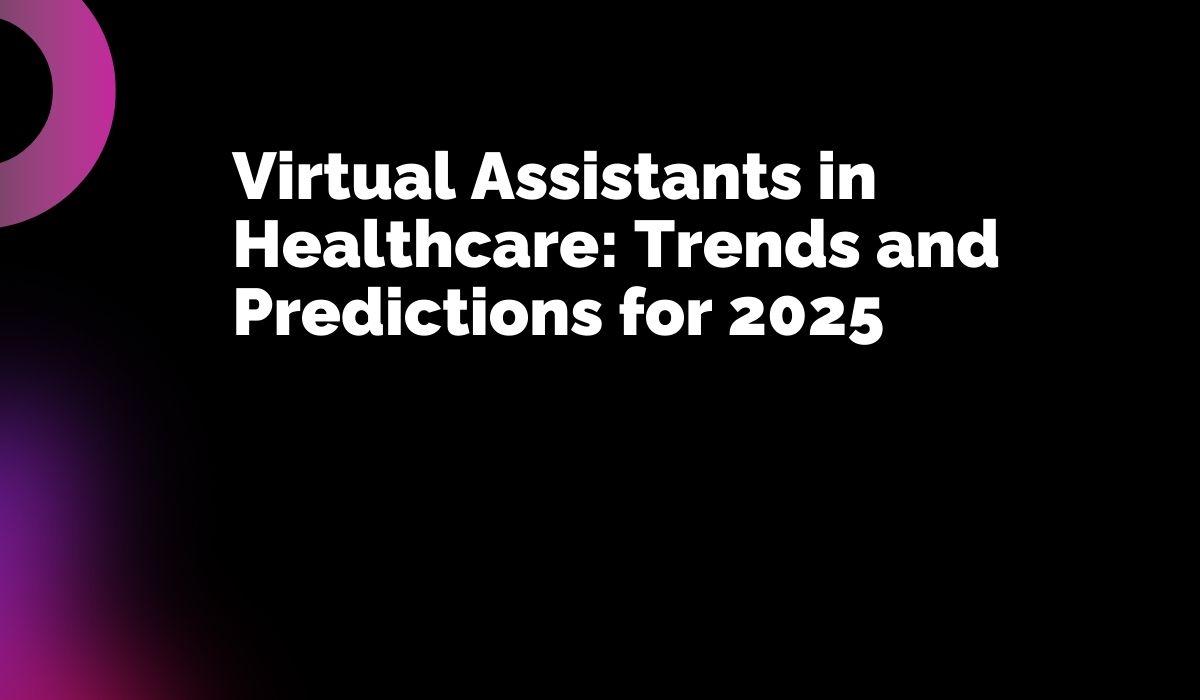Health
Virtual Assistants in Healthcare: Trends and Predictions for 2025

The healthcare industry is rapidly evolving, and technology continues to play a crucial role in enhancing patient care, reducing costs, and improving overall efficiency. One of the most significant innovations in recent years is the rise of Virtual Assistant for Healthcare. As we look ahead to 2025, the role of virtual assistants in healthcare is expected to expand, offering greater support to both healthcare professionals and patients. In this article, we will explore the trends and predictions for virtual assistants in healthcare for the year 2025.
What Are Virtual Assistants in Healthcare?
Virtual assistants (VAs) in healthcare refer to AI-powered tools designed to assist healthcare providers and patients with various tasks. These tasks can range from scheduling appointments, managing patient records, answering patient inquiries, to providing medication reminders, and even helping doctors make informed decisions by analyzing medical data. One such service is Express Virtual Assistant, which offers specialized virtual assistant solutions tailored for the healthcare sector.
Virtual assistants leverage AI, machine learning, and natural language processing (NLP) to mimic human interactions and provide support that improves the patient experience and enhances the efficiency of healthcare practices. By automating repetitive tasks, VAs free up healthcare professionals to focus more on direct patient care, while ensuring that administrative tasks are handled seamlessly.
Key Trends Driving the Growth of Virtual Assistants in Healthcare
As we approach 2025, several trends are shaping the future of virtual assistants in healthcare. These trends reflect the increasing adoption of digital tools, growing patient expectations, and the need for better healthcare delivery.
1. Increased Integration with EHR Systems
Electronic Health Records (EHR) are essential to modern healthcare, and virtual assistants are becoming increasingly integrated with these systems. In 2025, it’s predicted that virtual assistants will be able to access patient data from EHRs more efficiently, offering real-time information to healthcare providers. This integration will enable VAs to automatically update patient records, track medical history, and streamline administrative tasks.
For healthcare professionals, this means more time spent on patient care, and for patients, it means more accurate and timely updates about their health.
2. Enhanced Patient Engagement
Patient engagement has always been a priority in healthcare, but with the rise of virtual assistants, it will reach new heights in 2025. Virtual assistants will play an essential role in improving the patient experience by offering personalized health advice, answering questions about symptoms, and reminding patients of appointments or medication schedules. They can even follow up with patients to ensure they are adhering to treatment plans, contributing to better health outcomes.
By 2025, we can expect virtual assistants to utilize data from wearable health devices to provide real-time insights and recommendations, making it easier for patients to manage chronic conditions such as diabetes or hypertension.
3. Voice-Activated Assistants
The use of voice-activated technology is one of the most significant trends in the healthcare industry. Virtual assistants that can respond to voice commands, like Amazon’s Alexa or Google Assistant, are already being adopted in various healthcare settings. In 2025, these voice-activated assistants will become even more sophisticated, allowing healthcare professionals to dictate notes, schedule appointments, and access patient data hands-free.
Voice-enabled assistants will be particularly helpful for doctors and nurses in busy hospital settings where they need to multitask while interacting with patients or updating records.
4. Telemedicine Support
Telemedicine has become a significant part of healthcare, especially following the global pandemic. By 2025, virtual assistants will play a pivotal role in telehealth services. They will be able to assist in scheduling virtual appointments, conducting initial patient assessments, and even triaging medical conditions based on symptoms.
Moreover, virtual assistants will help healthcare providers manage telemedicine platforms more efficiently, ensuring that patients have a seamless experience during virtual consultations.
5. AI-Driven Decision Support
AI-driven decision support systems are rapidly becoming an indispensable tool for healthcare professionals. In 2025, virtual assistants will evolve to provide doctors with more advanced AI-powered decision support, analyzing medical data, lab results, and clinical notes to offer recommendations based on best practices and current medical guidelines.
These assistants will aid in diagnosing conditions, predicting patient outcomes, and even suggesting treatments, all while reducing the chances of human error.
Predictions for Virtual Assistants in Healthcare by 2025
1. Widespread Adoption Across All Healthcare Sectors
By 2025, virtual assistants will become a standard feature in healthcare practices, hospitals, and clinics worldwide. As AI and machine learning technologies advance, healthcare providers will increasingly rely on virtual assistants to streamline operations, reduce administrative burdens, and improve patient care. From primary care to specialized medical fields, VAs will play a critical role in almost every aspect of healthcare delivery.
2. Greater Customization and Personalization
As AI systems become more sophisticated, virtual assistants will provide a more personalized healthcare experience. These assistants will be able to learn from individual patients’ preferences, medical histories, and behaviors to offer tailored support. For example, a virtual assistant might recommend specific lifestyle changes based on a patient’s unique health data, making healthcare more proactive and personalized.
3. Improved Data Security and Privacy
With the integration of virtual assistants comes an increased need for robust data security and privacy measures. By 2025, virtual assistants in healthcare will be equipped with advanced security features to protect sensitive patient data. Blockchain technology and end-to-end encryption are expected to play a significant role in ensuring the confidentiality and integrity of patient information, while still allowing seamless interaction with healthcare professionals.
4. Collaborative Workflow for Healthcare Teams
Virtual assistants will also help foster more collaborative workflows among healthcare teams. In 2025, VAs will assist in coordinating care across multiple specialists, ensuring that all team members have access to the same up-to-date information. By acting as a bridge between different medical professionals, virtual assistants will help create a more cohesive and streamlined healthcare experience for patients.
5. Cost-Effective Solutions for Healthcare Providers
With healthcare costs rising, virtual assistants will provide an affordable solution for healthcare providers looking to enhance efficiency and reduce overhead costs. By automating administrative tasks and reducing the need for extensive human resources, virtual assistants will save healthcare organizations money while improving patient care. As the technology matures, the cost of implementing virtual assistants will decrease, making them accessible to more healthcare settings.
Conclusion
Virtual assistants are poised to revolutionize healthcare by 2025, offering a wide range of benefits to healthcare providers and patients alike. From streamlining administrative tasks to enhancing patient engagement and improving decision support, VAs will become an indispensable part of the healthcare ecosystem. As AI and machine learning technologies continue to advance, the role of virtual assistants in healthcare will only grow, making healthcare more efficient, personalized, and accessible for everyone.
Health
Understanding the Role of Disinfectants in Home Cleaning

Introduction to Disinfectants
Disinfectants have become a household staple, transforming modern cleaning routines. Unlike general cleaners that remove dirt, disinfectants are engineered to destroy bacteria and viruses living on hard surfaces. With the rise of public health awareness, products, and services are drawing attention to better home hygiene practices. The focus on cleanliness has led many to seek resources supporting smarter routines, such as Sparkulous, which offers valuable insights for maintaining a healthier home. The spotlight on disinfectants highlights their importance for families looking to maintain healthier indoor environments, especially when illness can spread rapidly within homes.
Recent times have seen a dramatic increase in surface disinfection, spurred by concerns over contagious diseases. According to CDC guidelines on disinfection, proper use of household disinfectants is crucial to breaking the chain of transmission for harmful pathogens. These products are essential for reducing the microbial burden on commonly touched surfaces, such as doorknobs, countertops, and bathroom fixtures.
Types and Mechanisms of Disinfectants
Disinfectants are available in various formulations, each proven to target specific microorganisms. Common options include alcohol-based sprays, bleach solutions, hydrogen peroxide, and quaternary ammonium compounds. These agents disrupt pathogens’ outer membranes or proteins, rendering them inactive within minutes. The EPA’s guide to approved household disinfectants provides a comprehensive list of products effective against various viruses and bacteria. Different surface types and application methods further impact how well these disinfectants perform.
Benefits of Using Disinfectants in the Home
Incorporating disinfectants into a regular cleaning regimen can provide measurable health benefits. They help reduce the risk of common illnesses, especially in busy homes with children, elderly residents, or immune-compromised individuals. Doctors and infection control experts recommend targeted disinfection in kitchens and bathrooms, where microbial contamination is most likely. A routine that includes effective disinfection supports the well-being of everyone in the home while minimizing cross-contamination from objects like phones, light switches, and remote controls.
Safe and Proper Use of Disinfectants
Effectiveness depends as much on correct use as on product selection. Every disinfectant comes with specific instructions regarding dilution, application, and contact time—the time the product must remain on the surface to achieve a complete kill. Following these directions can leave dangerous residues or even foster disinfectant-resistant microbes. Protective gloves, good ventilation, and storage away from children or pets are all vital safety steps. Keeping these basics in mind ensures maximum germ control with minimum risk to household members.
Integrating Disinfectants with Regular Cleaning
Disinfectants work most efficiently when applied after an initial cleaning to remove dust and grime. Cleaning first helps expose germs that may hide beneath visible dirt. Households benefit from setting a routine—wiping down high-touch surfaces daily and scheduling more thorough disinfections weekly. Using microfiber cloths, color-coding cleaning supplies, and regularly updating products ensures continued efficacy and hygiene.
Sustainable and Health-Conscious Choices
Awareness of environmental impacts and sensitivities has prompted many to seek disinfectants with safe, bio-based ingredients. It’s possible to balance hygiene with green practices by selecting EPA-approved products labeled as biodegradable or low in volatile compounds. Opting for sustainable packaging and responsible disposal keeps the home clean and lessens the overall environmental burden.
Staying Informed and Updated
Recommendations for best cleaning practices continue to evolve as science advances. Staying updated with resources such as the CDC or EPA ensures that chosen products are current and effective against newly emerging pathogens. Reviews of household routines and product lists, conducted a few times a year, help families keep pace with this changing landscape and make the best choices for wellness and comfort.
Health
How Provider Documentation Habits Must Evolve with CMS HCC V28

Shifting from CMS HCC V24 to V28 exposes every shorthand, autopopulated field, and copy-forward note that once slid through unnoticed; what felt “good enough” last year can now drain revenue and put compliance at risk. Providers who tighten their documentation today won’t just protect margins—they’ll give care teams clearer clinical stories to guide treatment tomorrow.
Old Habits That Hurt Under V28
Many clinicians still lean on boilerplate templates, partial diagnoses, or problem lists left to gather dust. Under the new model, a missing stage, acuity, or relationship word can strip an entire HCC from the claim. Multiply that gap across panels of chronic-disease patients, and small oversights grow into budget shocks.
Specificity Is the New Baseline
Version 28 rewards charts that state, for example, “Stage 3 chronic kidney disease secondary to diabetes with neuropathy” instead of “CKD.” That extra precision not only earns rightful risk weight but also guides population-health teams toward timely interventions. Adding a single qualifier may take five seconds, yet it prevents hours of coder queries and potential denials later.
Real-Time Prompts Beat Retro Queries
Relying on month-end chart review means the encounter is cold, memories have faded, and clinicians face another inbox full of clarifications. Lightweight, context-aware prompts inside the EHR nudge providers while the visit is still top of mind—“Add insulin-use status?” or “Specify heart-failure class?”—turning the note into a living clinical document rather than a rushed billing artifact.
Shared Dashboards Turn Data into Coaching
When coders, clinicians, and quality leaders view the same metrics—query turnaround, specificity rates, risk-score variance—blame shifts to collaboration. A weekly ten-minute huddle highlighting one high-impact documentation tip turns dry policy into actionable advice and keeps teams aligned on both financial and care outcomes.
Quick Wins You Can Start Tomorrow
Begin with high-variance specialties like nephrology and cardiology, where missed qualifiers cost the most. Update templates to remove outdated language, add prompts for stage and complication, and run a dual-scoring test on a recent month’s encounters to spot the biggest drops. Celebrate the first clinic that cuts their query backlog in half; peer recognition moves culture faster than any memo.
Measure What Matters Long Term
Track first-pass claim acceptance, denial rates linked to documentation, and downstream quality metrics such as avoidable readmissions. When leaders see improved patient outcomes traveling hand-in-hand with healthier RAF scores, they allocate more time and resources to sustain the habit change.
Conclusion
Progress from transactional note-taking to purposeful storytelling also elevates Outpatient CDI.
Health
The Art and Science of Massage Therapy: Techniques and Benefits

Introduction
Massage therapy, weaving together ancient tradition and modern science, is a testament to holistic healing. Across the globe, it has been cherished for centuries as more than just a moment of indulgent relaxation. Beyond its intricate maneuvers lie layers of physiological and psychological benefits that, when applied effectively, resonate with healing energy. Massage therapy encompasses techniques that enrich overall well-being, from enhancing bodily functions to stabilizing emotional health. This narrative urges understanding the therapeutic practices involved, shedding light on their artistry and scientific foundation.
The Many Techniques of Massage Therapy
Diversity in techniques characterizes massage therapy, each with distinct attributes targeting varied objectives. Among the most popularly practiced forms is the Swedish massage, revered for its smooth, flowing strokes that glide over the skin, efficiently elevating circulation and easing muscle stiffness. This technique is ideally suited to those grappling with stress, as it engages the body’s relaxation response through gentle manipulations. In contrast, the deep tissue massage delves into the body’s deeper muscle structures. It meticulously alleviates chronic muscle tension, often integral for individuals recovering from injuries or mitigating persistent muscular discomfort.
Additionally, sports massage is a specialized technique focusing on muscles commonly stressed by athletic activity. This form of massage depends on breaking down muscular knots, enhancing flexibility, and aiding recovery by stimulating blood flow to targeted areas. On a more sensory note, aromatherapy massage involves the integration of essential oils into the treatment, amplifying the emotional and physiological benefits while enveloping the client in soothing aromatic scents.
Skilled massage therapists play a critical role in applying these techniques. Their touch is informed by an intimate understanding of human anatomy and a practiced precision that ensures effectiveness and safety. They are adept at customizing each session to the client’s unique needs, optimizing therapeutic outcomes while ensuring that the treatment aligns harmoniously with the individual’s health profile and goals.
The Benefits of Massage Therapy
Unraveling massage therapy’s benefits reveals a tapestry of health improvements that extend far beyond the visible relaxation it elicits. On a physical level, regular massage sessions can dramatically alleviate pain, often acting as a complementary treatment for managing conditions like fibromyalgia and arthritis. Massage enhances blood circulation, facilitating nutrient delivery to tissues, promoting recovery, and reducing blood pressure. Furthermore, massage improves joint mobility, making it indispensable for those suffering from restricted movement or recovering from joint-related injuries.
The mental benefits of massage are equally profound. Stress, which is recognized as an omnipresent adversary in today’s fast-paced world, is substantially diminished through regular massage therapy. The treatment’s ability to lower cortisol levels while simultaneously boosting endorphin levels helps combat anxiety and depression and encourages improved mood and relaxation. As such, people often find improved sleep patterns and heightened mental clarity following massage treatments. These benefits foster holistic well-being, reinvigorating the mind and body.
Professionals trained in massage therapy bring their technique and a holistic understanding that includes lifestyle impacts. They help clients develop strategies that incorporate massage into broader wellness practices. Individuals can effectively address and navigate specific health challenges through tailored massage therapy plans by opting for such professional guidance. Learn more about massage and chiropractic care in Denver to explore how these treatments can support your overall health and wellness. Both therapies work synergistically to enhance physical mobility, alleviate pain, and promote mental relaxation. By integrating massage and chiropractic care into your routine, you can take a proactive approach to maintaining long-term health and vitality.
The Importance of Professional Guidance
While the allure of a DIY approach to massage might tempt some, the nuanced expertise of professional massage therapists remains unparalleled in delivering tangible health benefits. Trained therapists possess a profound understanding of anatomy, the intricate placement of muscles, and the network of pressure points that govern energy flow within the body. Their expertise is critical when customizing treatments suited to individual needs, especially when addressing complex health conditions. Professionals are trained to adjust massage techniques according to their clients’ unique physiological responses, ensuring an optimized therapeutic experience. They can identify areas that require particular attention and apply targeted techniques that provide maximum benefit while maintaining the client’s safety. The tactile intuition of experienced massage therapists, developed through years of practice, is something that self-administration cannot match.
In addition to their hands-on skills, therapists provide invaluable guidance on incorporating regular massage into one’s lifestyle, advising on frequency and technique variations that will yield the best results. This emphasizes the importance of seeking qualified professionals to ensure that massage therapy is effective and safely executed, avoiding the pitfalls that inexperienced administration might invite.
Conclusion
Massage therapy, rich in history and backed by science, offers a uniquely powerful avenue for fostering health and vitality. Its diverse techniques act as a symphony, addressing many physical and emotional needs that enhance the overall quality of life. Engaging with professional massage therapists ensures that individuals can unlock the full potential of massage, experiencing genuine therapeutic benefits safely and effectively. By trusting in the skilled hands of professionals, massage therapy manifests as an art that nurtures, a science that heals and a practice that enriches life’s journey toward holistic well-being.
-

 GENERAL6 months ago
GENERAL6 months agoFrom Fan Art to Original Works: The Diversity of doujindesu Creations
-

 Entertainment2 months ago
Entertainment2 months agoEnchantment & Excitement: Crafting Unforgettable Event Experiences
-

 GENERAL4 months ago
GENERAL4 months agoEngland Business Visa Requirements for American and International Citizens in 2025: A Guide for Entrepreneurs
-

 GENERAL2 months ago
GENERAL2 months agoCrossword Conundrum: The Significance of vault opener nyt crossword
-

 GENERAL2 months ago
GENERAL2 months agoExploring the World of nhentai.nef: A Comprehensive Guide for New Users
-

 Health6 months ago
Health6 months agoDiscovering gel ooru: The Ultimate Guide to This Unique Traditional Craft
-

 GENERAL5 months ago
GENERAL5 months agoLatest Trends in Men’s and Women’s Jackets for the Upcoming Season
-

 GENERAL7 months ago
GENERAL7 months agoWhy raterpoint is Revolutionizing Customer Feedback
